Florida is well-known for its palm trees. There are dozens of different species living there, but I would like to help you learn more about the most beautiful and attractive ones which thrive in the area.
It is not too hard to distinguish different species in all their uniqueness. You should carefully observe their trunks, leaves, and the way they grow, so the entire new world will flourish in front of your eyes.
Types of Palm Trees Based on Their Height
The quickest way to determine some of the palm trees is their height. You can easily recognize large, massive ones, which are tall more than 20 feet (6 m).
All palms lower than 20 feet (6 m) are considered small types of palm trees in Florida. They amaze everyone with their elegance, plus you can grow some of the species inside your home!
Are Palms Native to Florida?
Even though Florida is an ideal environment for palm tree growth, many are actually not native at all. In fact, Florida ecologists have determined only 12 palm tree species originated in this state.
All other species were mostly imported from South America and Southeast Asia. Nowadays, all of them together form a beautiful whole that makes this part of the US a real palm tree state. Let’s enjoy all of them!
Types of Palm Trees in Florida
1. Cabbage Palm (Sabal palmetto)
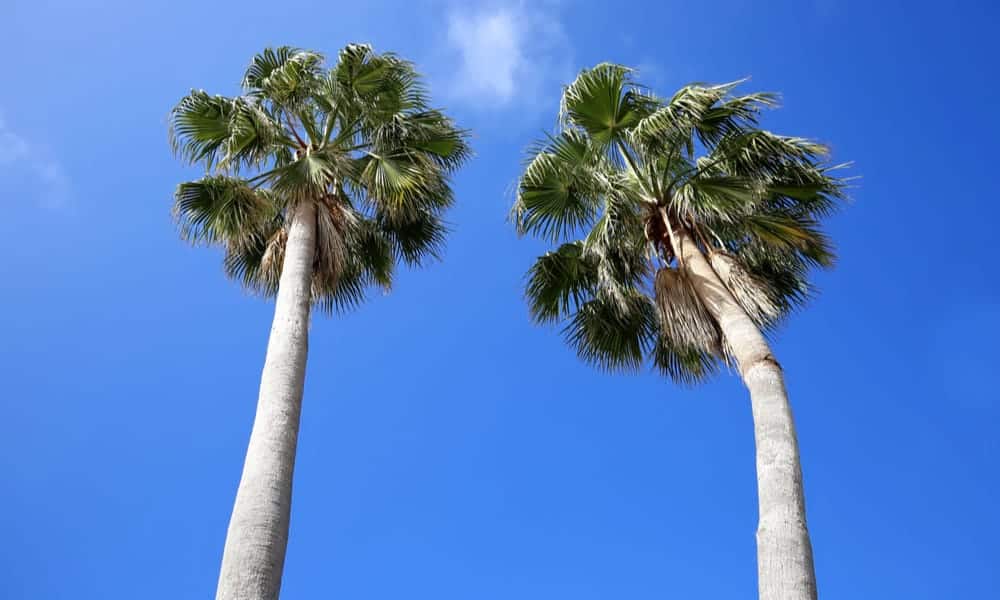
Cabbage palm (swamp cabbage, common palmetto, cabbage palmetto, blue palmetto) is one of 15 known palmetto palm species native to the southern US, the Bahamas, and Cuba. You can see this palm tree anywhere from southeast North Carolina and Florida to Texas in the US.
It is an adaptable plant that grows well in both sun-scorched prairie and dark flooded swamps. Amazingly, the 65 feet (19.8 m) high tree is tolerant of salt, freezing, and drought, plus it is practically disease-free.
Since it is a native palm in Florida, it is the official tree of this state. The palm has a tan or brown trunk with so-called boots, the leftovers of old leaf bases. They make a crisscross pattern along the trunk and become smooth and light brown or grayish the closer they get to the top of the tree.
At the top of this high tree, you can see the frond costapalmate with a defined midrib that extends into the blade. At its end is the fan-shaped, 3 to 4 feet (0.9 – 1.2 m) long shiny green leaves that look like palmate fronds.
The flowers emerging in 3 to 8 feet (0.9 – 2.4 m) long clusters that this palm produces are small, creamy-white, and fragrant, while the eatable fruit is round and black.
2. Bismarck Palm Tree (Bismarckia nobilis)
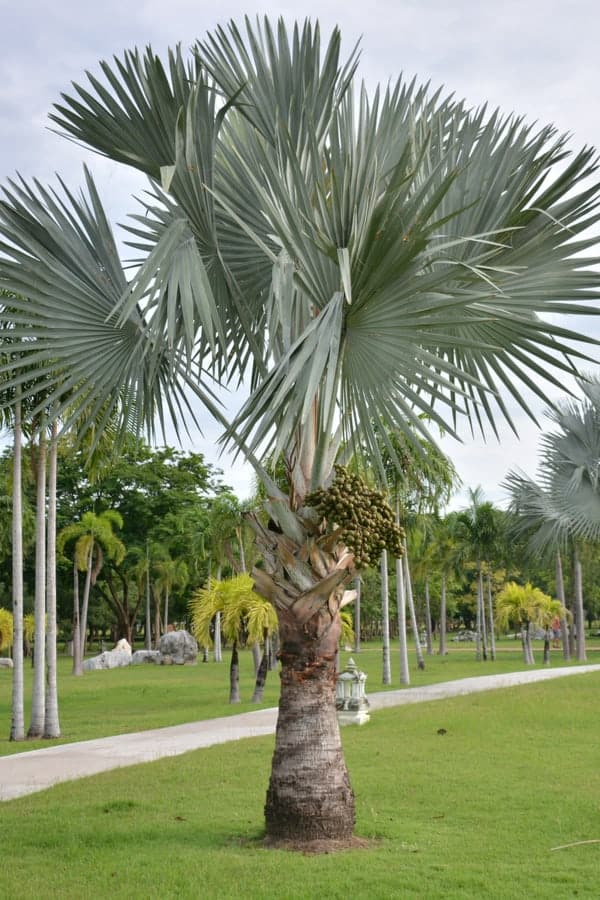
A silver Bismarck palm tree (Bismarckia) is a monotypic genus of flowering palms native to Madagascar. It was named after Otto von Bismarck, the first chancellor of the German Empire, while the Latin word ‘Nobilis’ means ‘noble.’
When it grows in South Florida, where the soil is moderately wet and well-drained, this stunning palm can grow 40 feet (12 m) in height. It reaches a width of 10 to 16 feet (3 – 4.9 m), with a trunk thick up to 18 inches (46 cm) in diameter.
The attractive silvery-green palmate leaves are usually about 4 feet (1.2 m) long. Since this palm grows slowly, it doesn’t require too frequent trimming. Even though this exotic tree thrives in warm climates and the sunniest areas, it can actually tolerate temperatures of 15 F (-9.5 C) once established.
3. Canary Island Date Palm (Phoenix canariensis)
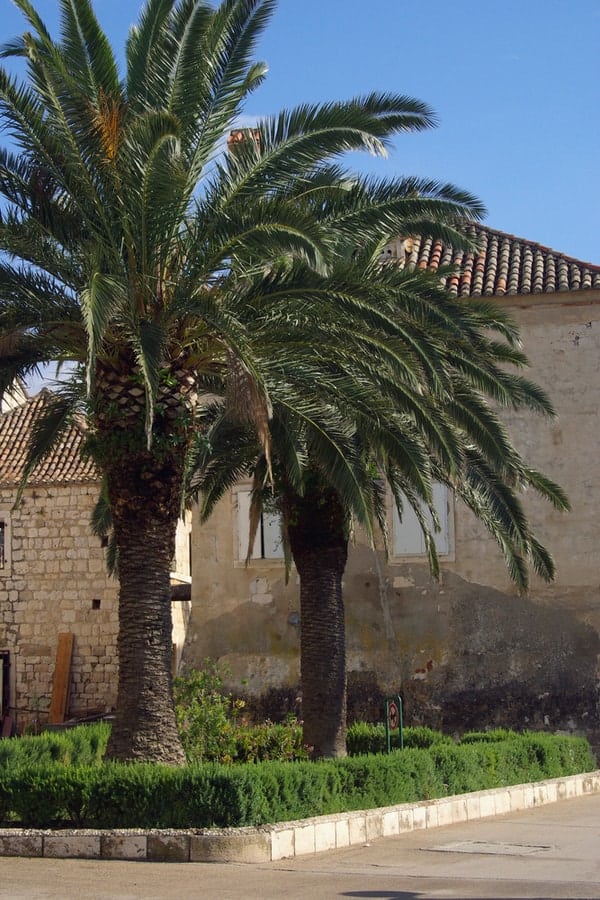
Canary Island date palm (Canary palm tree, pineapple palm) is a flowering plant that originated in the Canary Islands. An approximately 60 years old tree has a pineapple-like trunk thick up to 30 feet (9 m) in diameter, with ferns that come out of it.
A mature tree can reach 65 feet (20 m) in high and spread about 40 feet (12 m) wide. However, the speed of this palm growth is slow, and it can’t reach more than 10 feet (3 m) during the first 15 years after planting.
The dark-green pinnate leaves, which are approximately 11 to 20 feet (3.3 – 6 m) long, form an attractive crown with 80 to 100 leaflets at the top of the palm trunk. Be careful because of highly sharp spines formed at the base of the large, divided leaves, so-called fronds.
After the blossom white or gray flowers, the palm will produce ornamental but edible yellow to orange, 0.8 inches (2 cm) long dates in summer.
4. Chinese Fan Palm (Livistona chinensis)
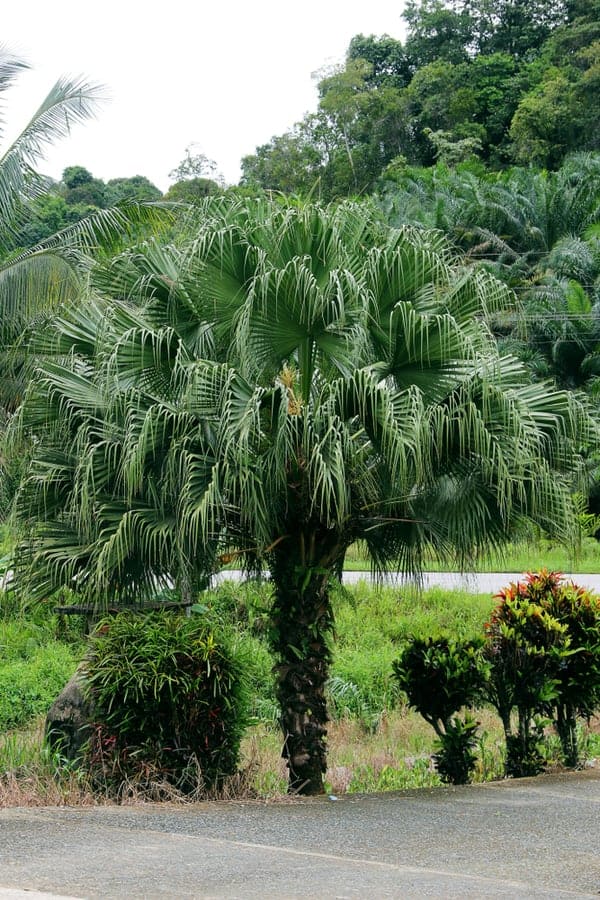
Chinese fan palm (fountain palm) is a subtropical tree that originated in Japan, China, and Taiwan, but successfully naturalized in Florida. However, it is classified in the group of invasive species in some parts of this state.
The advantage of this palm tree is that you can grow it inside as a potted houseplant if you don’t have enough space in your garden.
The tree got the name after its fan-shaped leaves that droop down from the crown like a fountain. It is a hardy, slow-growing palm that reaches the heights of 30 to 50 feet (9 – 15 m) and can spread about 12 feet (3.7 m) wide.
When the tree is young, its deep-green or bluish-green, 6 feet (1.8 m) long leaves grow in circular, segmented fans. They develop spines in the beginning but lose them over time. After producing small yellow blooms emerging in clusters, the palm will develop blue-green or black oblong fruits.
5. Mexican Palm tree (Washingtonia robusta)
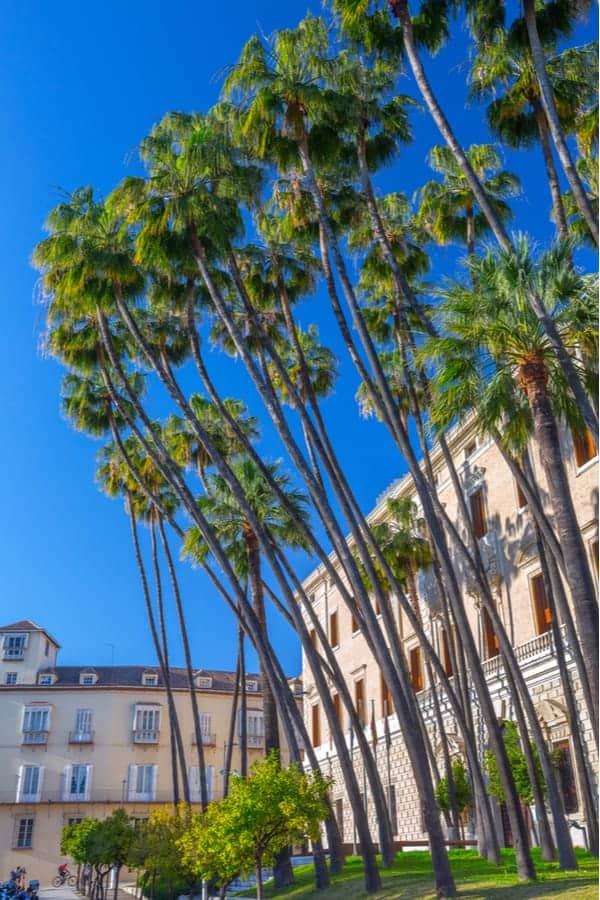
Mexican palm tree (Mexican washingtonia) is a fast-growing palm tree native to northwestern Mexico but naturalized in Florida and Hawaii. It is an excellent idea to grow this cold-hardy, salt-tolerant palm in a coastal area.
Since the narrow, 80 to 100 feet (24 – 30.5 m) high reddish-brown trunk has only 2 feet (61 cm) in diameter, this palm tree is at risk of breaking during a hurricane.
On its top thrive crowns with 3.3 to 5 feet (1 – 1.5 m) long, fan-shaped bright green leaves with leafstalks that feature an attractive red stripe on the underside.
Clusters that this palm produces are full of lovely small white flowers placed on a yellow stem. Its small, blue-black, round fruit is edible but not tasty.
6. Coconut Palm (Cocos nucifera)
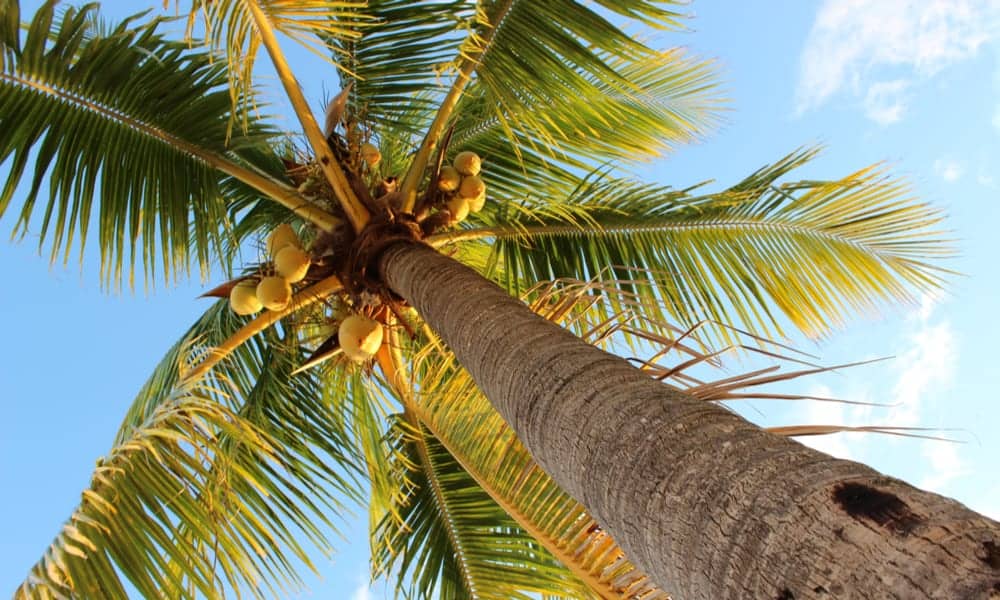
Coconut palm is the only remaining species of the Cocos genus, better known as the tree of life. The term coconut comes from the old Portuguese word coco, meaning ‘skull’ because of the concavity in the fruit shell.
Even though this is one of the most massive palms in Florida, many people grow it inside. When you let it thrive freely and provide enough space for its leaves, coconut palm can reach more than 80 feet (24.4 m) in height with 20 feet (6 m) wide fronds.
When someone mentions palm trees, most people think on this one with greyish trunks ringed with scars left behind the old leaves. Once mature, the trunk becomes smooth. It is usually slightly curved, and a bit swelled in the base.
A crown on the top contains 25 to 30 pinnate, 18 feet (5.5 m) long, and 6 feet (1.8 m) wide leaves with approximately two hundred leaflets, long about 2 feet (60 cm) each. These leaves won’t last forever. The mature palm forms new ones every 2.5 to 3 years and rejects the oldest ones every month.
After 4 to 6 years from planting, coconut palm starts producing clusters with sweet-smelling flowers in spring. The fruit is well-known, delicious coconuts.
7. Paurotis Palm (Acoelorrhaphe wrightii)
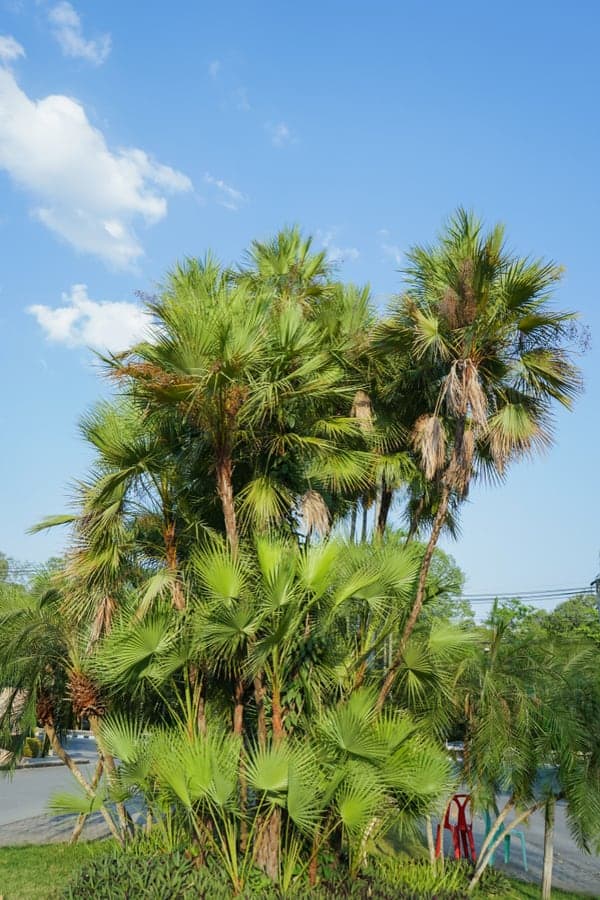
Paurotis palm (Madeira palm, everglades palm) is native to Mexico and Central America, but it also grows in swamps of southern Florida. It prefers dense stands and tolerates sandy soil excellently.
In ideal conditions, this fascinating palm tree with fan-shaped, 3 feet (91.5 cm) wide fronds can reach 23 to 30 feet (7 – 9 m) in height. So, it is not the best choice for growing in a container.
From the thin, reddish-brown trunk wrapped with fibrous matting, grow bright green leaves, which are silver on the underneath. You can spot retain leaf bases in the trunk surface, so-called boots.
This palm produces small, light green or white flowers that grow in clusters, and tiny, red-orange fruit becomes black when ripe.
8. Queen Palm (Syagrus romanzoffiana)
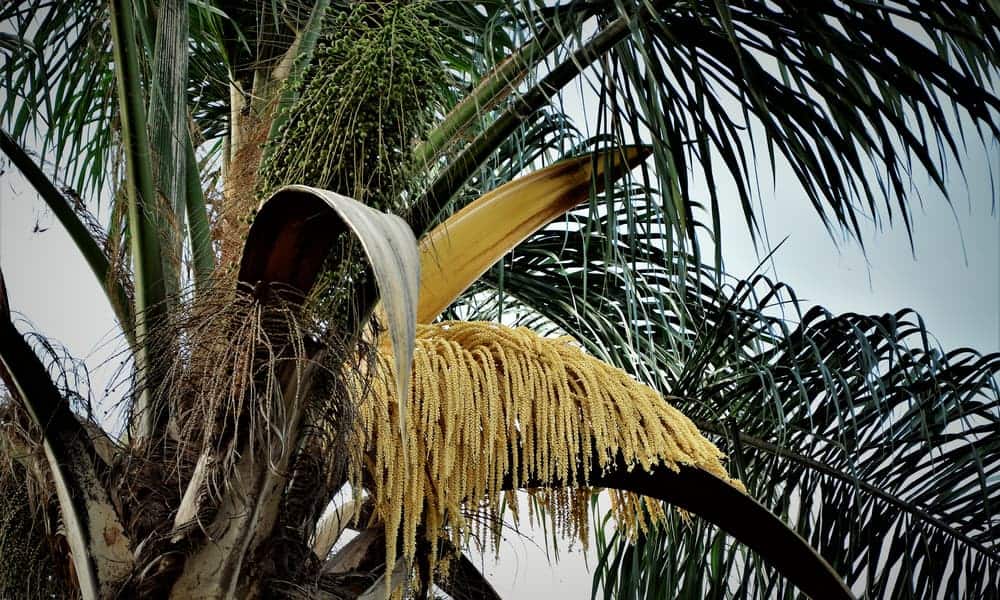
Queen palm (cocos palm) originated in South America, but many people grow it as an ornamental garden tree throughout the world.
It was named after Nikolay Rumyantsev, an Imperial Chancellor and patron of the Russian exploring voyages, who sponsored the first Russian expedition sailing around the world.
It is a single-trunked, fast-growing, 40 to 50 feet (12 – 15 m) high palm with glossy, pinnate leaves with multiple leaflets. They create an elegant, 25 feet (7.6 m) wide canopy that makes this palm a beautiful landscape tree.
In summer, this palm produces large ornamental clusters with miniature creamy or bright orange dates, which mature into messy, sticky, light orange fruits.
9. Pindo Palm (Butia capitata)
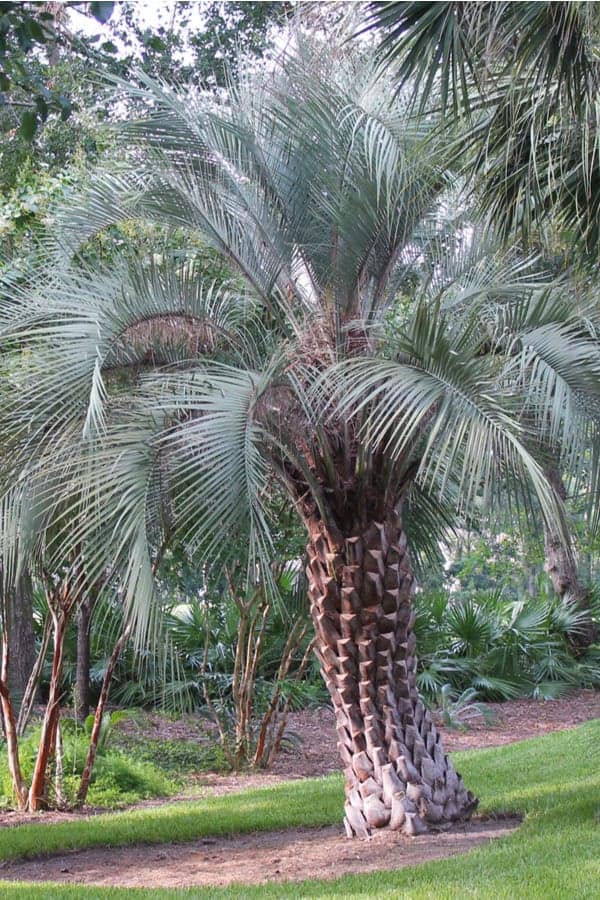
Small, slow-growing Pindo palm (jelly palm) originated in Brazil, but you can find it in Florida, as well. This cold-hardy palm with a gray, exceptionally thick trunk can reach 1 to 1.5 feet (30.5 – 46 cm) in diameter and 15 to 25 feet (4.6 – 7.6 m) in height.
It produces white, yellow, or orange-red flowers that make one female and two male clusters. Later, you can see edible, round, orange to brown fruit you can use to make jelly.
Its feather-shaped, pale yellowish-green, 7 feet (2 m) long leaves, with 3 feet (91 cm) long leaflets grow at an angle of 45 degrees.
10. Windmill Palm (Trachycarpus fortunei)
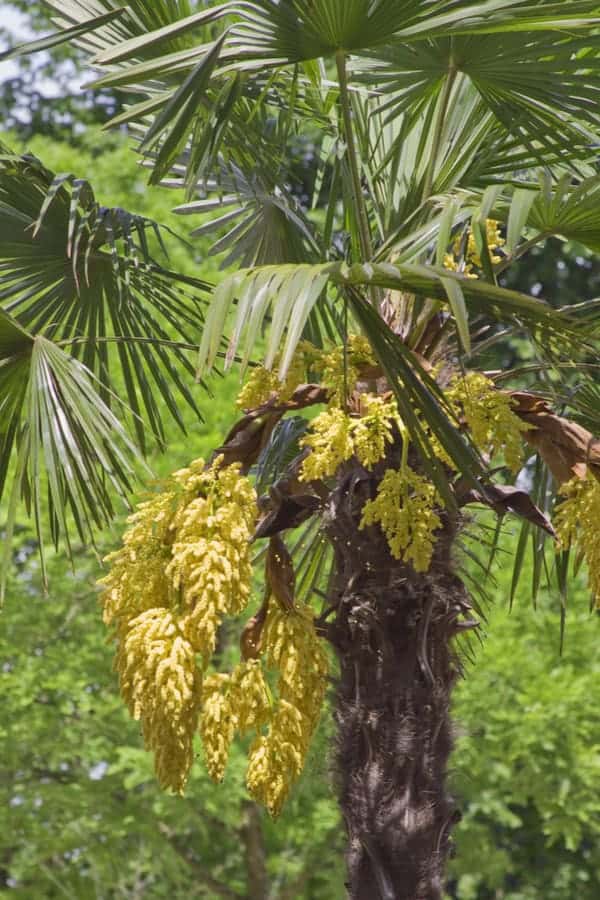
Windmill palm (Chusan palm, Chinese windmill palm) is a hardy, single-stemmed, evergreen palm native to Japan, China, India, and Myanmar. The lovely, slim, rough trunk of this slow-growing palm is approximately 20 to 60 feet (6 – 18 m) high and up to 6 to 12 inches (15 – 30.5 cm) in diameter.
The fan-shaped, 4.5 to 6 feet (1.37 – 1.8 m) long leaves, with 3 feet (0.9 m) long leaflets, are placed on 2 to 3.5 feet (61 cm – 1 m) long petioles. Depending on the specimens, some palms have straight or drooping leaf segments.
Its lovely, greenish female and yellow male flowers are approximately 0.1 to 0.15 inches (2.5 – 3.8 mm) long. Keep in mind that one palm can produce only male or female blooms. You can expect to see small, yellow, kidney-shaped fruit in fall that turns blue-black when ripening.
Taylor form of the windmill palm (Trachycarpus fortunei var. ‘Taylor form’)
This slow-growing variation of windmill palm (Raleigh, Taylor hardy) can stand low temperatures. It is well-known for its 20 feet (6 m) high trunk looks like wrapped in burlap.
Bulgaria windmill palm (Trachycarpus fortunei var. ‘Bulgaria’)
It is an extremely hardy, 20 feet (6 m) height variation of windmill palm. It has separate female and male trees that produce bead-like blossom clusters. Keep in mind that only female trees can produce blue-black berries.
11. Bottle Palm Tree (Hyophorbe lagenicaulis)
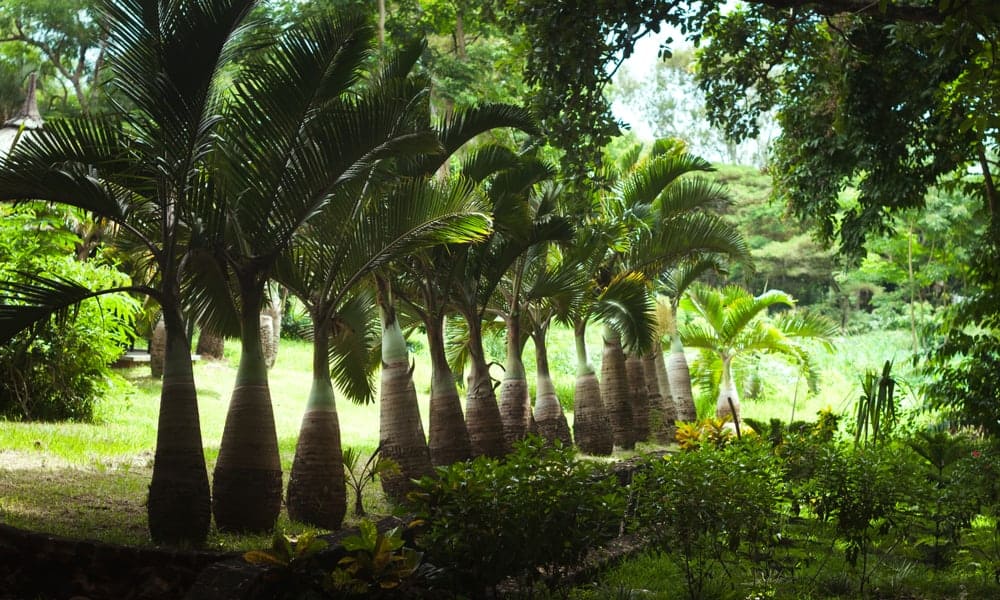
The bottle palm tree is a flowering plant native to Mauritius and naturalized in Florida and Hawaii, which are the only adequate areas for its growth in the US.
This small, 10 feet (3 m) high ornamental tree got the name because of a thick, short, and bottle-like trunk that looks somehow swollen at its base. In rare cases, it can reach 15 to 20 feet (4.6 – 6 m) in height.
You can see three to four huge, 12 feet (3.7 m) long palm leaves, with 2 feet (61 cm) long leaflets at the top of the trunk. The palm produces beautiful white flowers held on 30 inches (76 cm) long stalks and green-black, 1.5 inches (3.8 cm) long berries that turn black once ripened.
Since this palm is not too tall, you can grow it in a container if you live in a cold region. To keep it safe, you should bring it indoors in winter.
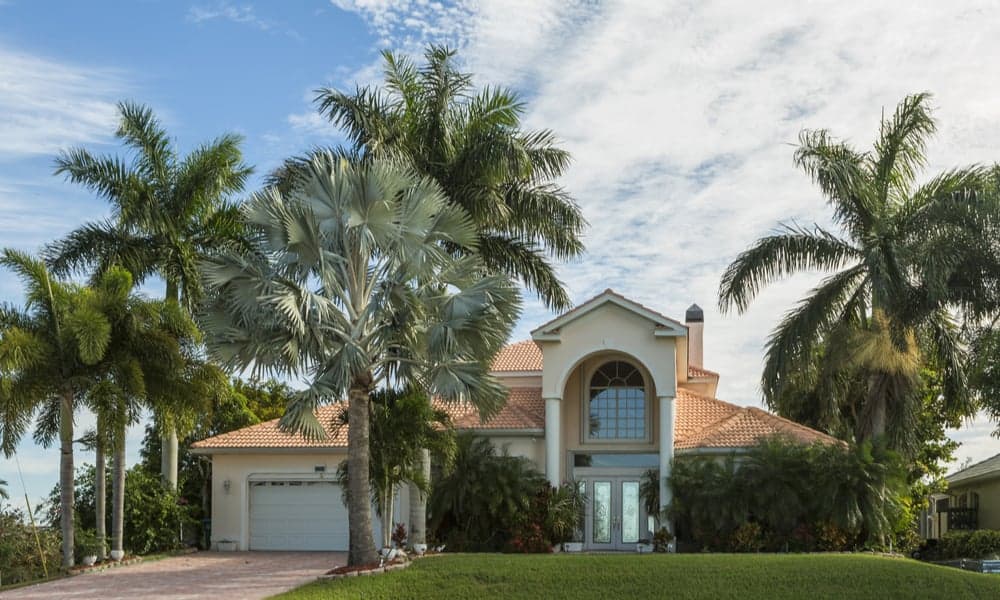
Leave a comment